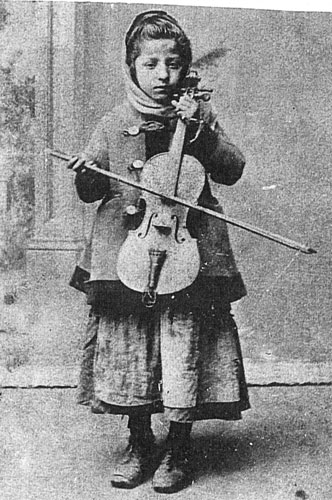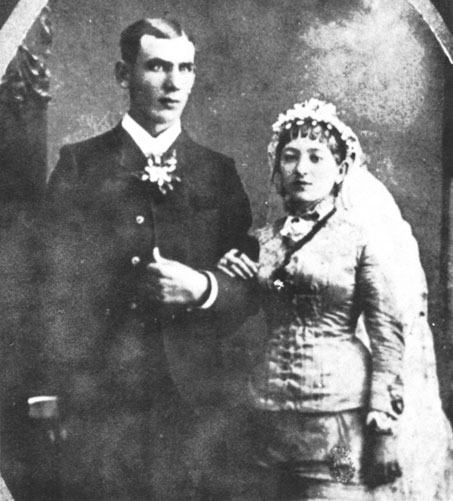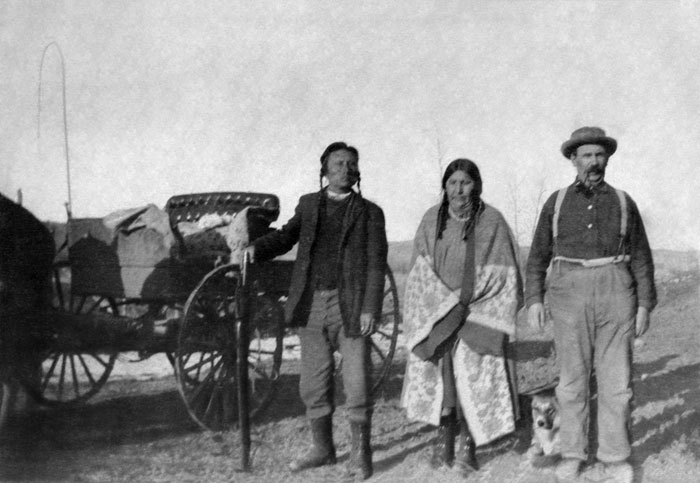Capitol Builders
Francesco "Frank" Abbate purchased the empty lot at 2836 W. Lyndale in February 1882 for $250. Frank and his brother Raffaele were professional musicians, as were their sons. Their daughters were trained in music as well. The two brothers and a sister had immigrated to Chicago from Italy with their spouses and children in the early 1870s.

Maria Gaetana Abbate soon after arriving in Chicago. Source: Ancestry.com
Frank Abbate may have improved the property at 2836 but he did not immediately build a house on it or live there. Instead, city directories before and after 1882 list him living at 113 DeKoven Street, a few doors down from Mrs. O'Leary's barn where the great fire had started a decade before.
Shortly before Frank passed away in 1889 he sold the lot on Lyndale to his daughter Marie Gaetana "Gita" and her husband Pasquale Petosa for $400.
Pasquale had come to Chicago as a teenager with his father Berardino Petosa in 1878 from Campobasso, Italy, north of Naples. In January 1882, they bought a small house at 2816 W. Palmer from developer John Johnston Jr. A few months later, the father and son were able to bring mother Filomena and the other siblings to join them in Chicago, but instead of moving to the new house, the family continued living in the Little Italy neighborhood for several years, perhaps in order to use the rental income from the Palmer house to pay off the mortgage. The poor sanitation of the tenement district may have contributed to Filomena's death from typhoid in the fall of 1885.
Pasquale and Gita Petosa were married in 1883. They were about to have their fourth of thirteen children when they purchased the lot at 2836 in 1889, so they must have been eager to build a house there. Pasquale worked as a stone cutter, as did his brother Frank who lived on the other side of the block with their father on Palmer. But stone was expensive. The family built a small brick cottage that was likely increasingly cramped as the family grew.

Pasquale Petosa & Maria Gaetana Abbate wedding, 1883. Source: They Gazed on the Beartooths, by James Annin
Pasquale and Isabella Mesce had been living next door for several years. How well did the neighbors and their children get along? Both fathers were stone cutters who had come about the same time from the area around Naples, though not the same town. Pasquale Mesce was seventeen years older than Pasquale Petosa. Only the youngest Mesce children would have been playmates for the oldest Petosa children. Still, the families must have enjoyed some camaraderie with their side-by-side brick buildings amidst the wooden houses of their mostly Scandinavian neighbors.
Pasquale's childhood friend Michelangelo Jacobucci immigrated in 1878 and changed his name to Mike Jacobs. He worked in Canada briefly before coming to Chicago where his relative Gabriel had already settled. Mike and Gabriel were skilled stone-cutters who gained a reputation as fine craftsmen on big downtown projects such as the new City Hall, completed in 1885, and the Art Institute, built in 1893. Gabriel and Mike married two sisters from New York and the two families lived together at 2838 W. Palmer in the early 1890s.
In 1899, Mike Jacobs was invited out west by the owner of the Montana Sandstone Company, which had just won the contract to provide cut stone for the new state capitol in Helena. The following year, Jacobs moved to Columbus, Montana, a small town west of Billings, to run the quarry there. He hired a local crew of workers and invited a number of skilled Italian stone-cutters from Chicago to join him, including his friend Pasquale Petosa. In January 1901, Petosa sold the house at 2836 to relatives Joseph & Rose Russo for $1,800. Gita and the eight children made the long train journey west once their house in Montana was set up.
Pasquale Petosa bought a ranch outside of town and built a log cabin overlooking the Stillwater River and the Beartooth Mountains. What must it have been like for the family who had lived in a cramped house on Lyndale Street to now see the wide horizons out on the prairie?

Pasquale Petosa with new neighbors in Montana. Source: Ancestry.com
The quarry in Columbus provided cut stone for a number of major projects, including government buildings in Butte and Billings, the Helena Cathedral, the Masonic Temple in Missoula and smaller commercial buildings across Montana. In 1910 the state capitol needed an expansion, but a new granite quarry in Butte won the government contract, which included an agreement to lease equipment from the Columbus quarry. After that project finished, the equipment was never returned and the quarry business in Columbus never recovered. Pasquale and son Henry stayed in the area after the quarry closed, and started a small business carving artful tombstones from the stone blocks left behind.
Their second-cousins, the twelve children of Joseph & Rose Russo, did not squeeze into the little house at 2836 but instead stayed in the Little Italy neighborhood. In 1908, the Russos purchased 2838 next door and rented out the two houses. Joseph worked as a professional musician, and several of his children did as well. After Joseph and Rose passed away in the early 1920s, their sons Michael and Daniel inherited the Lyndale houses. Both sons were working as musicians in theater orchestras in Kansas City and Sioux Falls, so perhaps they had no interest in being landlords in Chicago. The brothers sold both houses to John & Julia Langhoff in 1924.
Lee Balek grew up in the house at 2836 in the early 1960s. She remembers the red brick front of the house. Her father excavated the dirt basement and put in a concrete floor. Other home improvement projects did not go as well. She recalls that he dismantled a bathroom and never managed to put it back together. The entire family made do for years with a makeshift bathroom at the back of the house. Meanwhile, the brick exterior of the house was falling apart. A basement flood in 1970 damaged the foundation. Lee blames her father's heavy collection of malfunctioning televisions (he hoped to repair them) for weakening the walls of the house, causing a noticeable bulge in the exterior walls. After the family sold the house, the next owner replaced the deteriorating brick with cinder block walls and rebuilt the interior to straighten the little house. The house at 2836 now shows little evidence of the original brick cottage built by the Petosa family.
